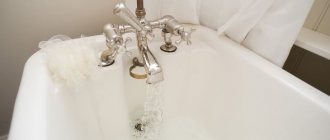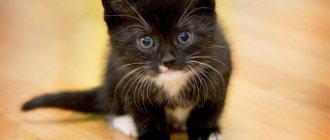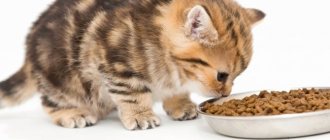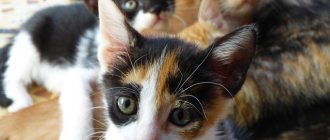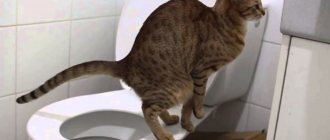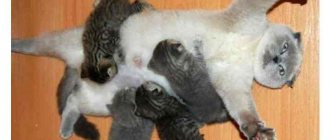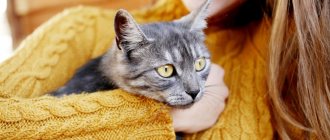Is vomiting hair normal?
Cats constantly lick themselves, swallowing large amounts of fur, but cannot digest it.
Therefore, nature has a cleansing mechanism that allows you to get rid of it. The gastrointestinal tract of animals is designed in such a way that hairs accumulate in the stomach, but enter the intestines in minimal quantities.
The body periodically needs cleansing, so the gag reflex is triggered. The pet vomits wool sausages or dense lumps.
What frequency of regurgitation would be normal?
It is considered normal if a cat vomits hair about three times every 2-3 months. But these data are relative. What matters is the thickness, length of the coat, general health, and molting periods.
Treatment
The cat hides in dark places - the main reasons and what the owner should do
If the presence of symptoms indicates the formation of hairballs in the cat's gastric tract, and the veterinarian confirms this, it is necessary to rid the animal of them and take measures to prevent their further formation using various veterinary drugs.
Note! In short-haired breeds, dead hairs can also accumulate in the stomach, only, due to their rigidity, they stick together into prickly lumps, which sometimes stick to the walls of the mucous membrane and provoke repeated vomiting.
Drug treatment
Before starting to use medications, it is necessary to find out the cause of vomiting, this will help to more accurately select treatment and dosage of drugs. In general, to empty the stomach, metoclopramide is used at a dose of 0.2-0.4 mg per kilogram of the cat’s weight, ranitidine - 5 mg/kg, cerucal or even no-shpa at a dosage of 0.1 mg per 1 kilogram of the animal’s weight. However, long-term medication is not required.
Also a popular medication for the treatment of hairy stomach lumps is malt paste. It is squeezed directly into food, and cats eat it with pleasure.
Malt paste is used to treat hairballs in the stomach
Consuming the paste helps remove ingested villi naturally along with the animal’s feces and further prevents lump formation in the stomach and intestines. If you use it regularly, even long-haired cat breeds will stop vomiting hair.
Special food
Manufacturers of cat food have made sure that tailed fluffies do not have such situations when a cat or cat vomits hair - for this they produce special food (for example, “Cat Show Hairball Control”, “Proplan” - a line for domestic cats), which have contains additives that prevent swallowed wool from rolling into lumps and getting stuck in the stomach or intestines. It is enough to feed your pets a couple of kilograms of this food for several months.
If your cat frequently burps clumps of ingested hair, veterinarians also recommend following a grain-free diet in its diet, since these animals are carnivores, their natural food is protein, and grain products contain many carbohydrates, which change the microflora of the gastrointestinal tract so much that its mobility is reduced. and the swallowed wool ceases to come out of it.
ethnoscience
Traditional medicine recipes in this matter are based on the instinctive ability of cats to determine when it is time for them to cleanse their stomachs of “garbage.” Thus, many pet stores sell already sprouted grass in containers. Cats eat it with great pleasure because it helps digestion and gets rid of stomach troubles.
Cats eat grass to cleanse their stomachs of fur.
For reference: young shoots of wheatgrass, which often grows as a weed in yards and even ends up in flower pots, are especially helpful.
If urgent help is required in a situation where the cat often regurgitates fur, and there are bile impurities in it, decoctions of flaxseed or chamomile, as well as a further diet including chamomile decoction and plenty of water, will help.
The total recommended daily consumption of medicinal decoctions is from 1 to 3 tablespoons, determined by the weight of the animal and the severity of its condition.
Causes of vomiting
Periodic vomiting of fur in cats is normal. This is a natural physiological process.
The reasons for frequent vomiting are as follows:
- an increase in the amount of wool ingested;
- deterioration of motility in the upper gastrointestinal tract.
The following factors can provoke an increase in the volume of ingested fur:
- fleas leading to the development of allergic dermatitis;
- pathologies of the skin that provoke itching;
- exposure to stress.
A decrease in gastrointestinal motility is observed in the presence of pathologies of the gastrointestinal tract that occur in a chronic form. Negative changes are observed with food intolerance. In this case, colitis is possible, and blood appears in the stool.
Daily nausea
Vomiting observed every day indicates problems with the digestive system. The following negative changes provoke the onset of the pathological process:
- inflammation of the rectum;
- pancreatitis;
- triaditis;
- malignant tumors;
- lymphoma;
- carcinoma.
Frequent vomiting is provoked by stress, so special attention should be paid to the psycho-emotional state of the pet.
Fur in a cat's stomach: symptoms
It is very important to identify symptoms in the early stages of the disease. This is not so easy to do, because hairballs in an animal, as well as their regurgitation, are a normal situation, which, if it malfunctions, is not always obvious to the pet owner.
- Next, we will look at the main symptoms that determine the presence of a deviation in an animal:
- As already mentioned, the presence of wool in the stomach in large quantities gives a feeling of fullness, which, of course, is false. If it noticeably and often happens that the cat simply comes up to the bowl, eats just a little and leaves, then the fur is probably clogged up in the stomach and digestive tract. The animal also has problems with stool, or more precisely: constipation; it is difficult to go to the toilet when the intestines are clogged with hair. It is worth monitoring how often your pet goes to the litter box and in what volumes.
- This point is a direct continuation of the previous one. Due to the fact that the cat does not eat, its immunity is depleted. The amount of vitamins and minerals is reduced, which means the coat acquires a painful dull color, becomes brittle and stiff.
- It is worth paying attention to your pet’s behavior. If a situation often arises when the cat wants to burp, but cannot, this is a sign that too much hair has accumulated. You need to take a closer look after eating, since that is when this happens most often.
- It is worth examining the cat's teeth and oral cavity. As already mentioned, wool can get stuck in the teeth, which means if it is there, then most likely there is excess in the stomach. Inflammation occurs, so it is necessary to clean the animal’s fangs of foreign objects.
- The pet's mood also changes. Apathy, indifference to games, much more sleep and a sedentary lifestyle. A cat is quite capable of hiding in a secluded corner and sitting there for a long time. This serves as a signal that the pet is sick, although it is not necessarily caused by fur in the stomach, so you should contact the veterinarian in any case.
At the slightest symptoms, you should contact an experienced veterinarian
, who will not only conduct a diagnosis, but also prescribe a course of treatment that will help the pet return to its usual lifestyle, appetite and the joy of playing with its owner.
Presence of undigested food in vomit
There are several reasons for the appearance of such symptoms. Among the most common are the following:
- Rapid absorption of food, overeating.
- Poor quality food. If there is a lack of protein in the feed, the absorption of nutrients slows down. The meat content in cheap feeds is only about 3%. The lack of protein is compensated by adding offal; it is also possible that there are chemicals in the composition, all of which can cause vomiting.
- Poisoning.
- Infectious diseases.
- Pancreatitis, colitis, gastritis.
- Intestinal inflammation.
- Helminthic infestations.
Treatment and prevention of hair vomiting in cats
Common methods of treating cats with hair vomiting:
- Internal administration of petroleum jelly. It has a laxative effect by softening the intestinal contents and stimulating the motility of the digestive tract, as a result of which the cat has bowel movements faster and easier. In this case, the drug is not absorbed (does not affect the functioning of the liver and pancreas), but leaves the body along with the animal’s feces. A single dose of the drug equal to 10 ml (forcefully injected into the mouth from a syringe without a needle) is considered prophylactic. For frequent constipation, a cat can be given up to 20 ml of oil for no more than 5 days. Next, you should replace the product with human drugs "Duphalac" (inside), microenema "Microlax" (in the rectum) or Lactusan (inside).
- Endoscopic hairball removal. This is a non-surgical method, it is used in veterinary clinics that are equipped with modern flexible endoscopes. Under ultrasound control, the doctor determines the location where the hair conglomerate is located. The cat is put under anesthesia, then the doctor uses a special device through the oral cavity to remove hair from the gastrointestinal tract.
- Abdominal surgery: the trichobezoar is surgically removed. Doctors often have to remove part of the intestine due to severe inflammation or tissue death.
As preventative measures to prevent vomiting with hair, it is optimal to use:
- special malt pastes for cats and ferrets;
- offer cats fresh grass (sprouted wheat or oats);
- periodically introduce a few drops of vegetable or fish oil into the animal’s diet;
- with natural feeding, increase the proportion of vegetables or dry fiber (purchased in pharmacies);
- Brush the cat during periods of heavy shedding and bathe it once (every few months).
Combing
Brushing is an incredibly pleasant and beneficial procedure for cats. It is recommended to carry it out from a young age in order to accustom the animal to a comb. Upon completion of the process, the cat should be treated to its favorite treat (this will consolidate the positive result).
Suitable accessories for combing are: combs without balls on the teeth (this prevents healthy hair from being torn out), rubber gloves (with a massage effect), cat slickers, furminators (unique trimmers that comb out the undercoat).
How to properly brush a cat:
- pet the pet;
- lay the cat on its side;
- carry out several combing movements in the direction of hair growth (from head to tail);
- turn the cat over on the other side and repeat;
- put the animal on its paws or sit it on the owner’s lap, comb the back, head, neck, tail;
- turn the cat over on its back and brush its belly.
Vomiting in kittens
Nausea in small kittens is extremely dangerous. The younger the pet, the more difficult it is to save it, even if timely medical care is provided. The resulting dehydration leads to death in the shortest possible time.
Often, nausea in a kitten begins due to congenital problems with the digestive system. The difficulty of therapy lies in the unpredictable reaction of the body to medications.
From the age of three months, the causes of negative changes in kittens are identical to the problems of adult animals.
What to do if your cat often vomits hair?
Your pet should be monitored and no medication should be used to stop vomiting. For this, there are professional feed additives or folk remedies.
Medications for hair removal
To remove hair naturally, specialized feed additives have been developed that can be given as a medicine and to prevent vomiting. At the same time, vomiting stops, the hairs do not bunch up, but come out with feces.
Be sure to read:
Vomiting in a cat: causes, what different types of vomit indicate, first aid, treatment, when it is not dangerous
You can get rid of hairs in two ways:
- Give more dietary fiber - fiber.
- Feed a product rich in fats.
Most often, the following means are used to remove hair:
- Phytomins : these are herbal collections enriched with minerals, vitamins, and fats. The feed additive combines the effects of cellulose, soluble fiber, and fat-like substances.
- Malt paste: the basis of the medicine is fats, malt and dietary fiber are the auxiliary components. The paste has an attractive taste.
- Treats for removing fur.
- Ready-made food containing components for removing hairballs. Premium and higher class feeds have these qualities. Food for sterilized cats must contain anti-bezoar components.
Folk remedies for removing hair from a cat's stomach
Cats walking outside occasionally nibble on young grass, which induces vomiting and clears the stomach of hairballs. But what to do in areas where there is winter? What to do if your pet does not go outside? For this purpose, grass seed mixtures are produced that contain only plants that are beneficial for cats.
Green food is grown on the windowsill so that the cat can safely eat it at any time. In addition to plant fibers, the grass contains vitamins that increase visual acuity.
Another approach is to relieve constipation. In this case, use Vaseline oil. This mineral fat-like substance irritates and at the same time lubricates the intestinal mucosa and promotes the rapid evacuation of food masses. Eliminates constipation. Unlike vegetable oils, it is not absorbed and does not overload the liver.
If the use of the above remedies does not stop vomiting, you should contact your veterinarian.
How to help your pet
Your doctor should tell you what to do if such problems arise.
It is important to identify the exact cause of vomiting . Therapy is carried out using medications. Traditional recipes can also be effective.
Preparations for removing hair from the body
Veterinary pharmacies sell special pastes that help remove hair from the stomach before lumps form, i.e. until the stage when digestive problems begin to develop.
The drugs are given strictly according to the instructions, they help:
- relieve your pet from nausea, constipation, intestinal blockage;
- eliminate loss of appetite;
- strengthen the coat, make it smooth and shiny.
Traditional methods
Folk methods will help to cope with the problem. Vaseline oil is used. Take 4 ml of the product into a syringe and pour it into the cat’s mouth in small portions.
It is important that the pet has time to swallow each portion. Due to this, the intestines are cleansed.
You can add 3-4 drops of fish oil or flaxseed oil to the food. These products also promote natural hair removal from the body.
Veterinary pharmacies and specialty pet stores sell grass seeds that can be grown at home as a houseplant.
It contains many vitamins and nutrients that a cat needs for development and normal life. When it is eaten, the animal’s stomach is cleansed of accumulated lumps.
Prevention
Hygiene features
Problems can be avoided if you brush your pet regularly.
To prevent problems with the cat’s gastrointestinal tract due to bezoars, it is recommended to carefully monitor the condition of the coat, especially during the molting period. The pet needs to be bathed with special shampoos depending on the length and thickness of the coat, and also combed regularly. If the hairs fall out slightly, 2 r. in 7 days. Long-haired cats should be brushed once every 2 days, and daily during the shedding season. Bathing a pet raised at home is allowed twice every six months. In between, you can use special napkins.
Daily menu
Veterinarians do not recommend mixing natural products with dry food or feeding your cat from the table. This provokes problems with the coat.
The animal's diet should be varied and rich in all necessary substances, in particular fiber. Periodically and only after consultation with a veterinarian, you should give your cat special food to improve the removal of hair from the stomach, taking into account the weight, age and health of the animal. It is important to ensure constant access to fresh water. To make control easier, you can buy an automatic drinking bowl for cats.
When you can’t do without veterinary help
Sometimes pets, while taking medications or excessively overeating food and grass, accumulate a large amount of hair. The animal cannot get rid of it on its own. Need help from a veterinarian.
The following symptoms are dangerous:
- daily nausea;
- the contents are released not in the form of sausages or lumps, but in separate shreds, the presence of stomach contents, mucus, and blood inclusions is noted;
- attempts to spit out the lump fail;
- the animal's fur loses its shine, the cat looks untidy, stops washing itself and licking itself;
- stool is hard, dense;
- constipation;
- presence of wool particles in feces;
- poor appetite, complete refusal to eat;
- cough;
- lethargy, apathy. The cat stops playing and tries to hide;
- the stomach is swollen and painful.
Such symptoms indicate the presence of serious problems with the gastrointestinal tract, intestinal obstruction. It is necessary to begin therapy under strict medical supervision.
If medications fail to relieve unpleasant symptoms, then surgical intervention is resorted to.
Why does a cat vomit hair: normal or pathological?
Cats that walk outside and eat natural products solve the problem on their own: by eating green grass, the plant fibers of which prevent the hairs from getting tangled and they come out naturally. If the hairballs are large, vomiting occurs. Repeated vomiting is considered normal.
But when your pet is constantly vomiting, he is depressed, or there are repeated urges to no avail, help is needed. Constipation occurs, which can be eliminated at home, or intestinal blockage, in which case you should consult a veterinarian.
Cats of long-haired breeds that do not walk outside and consume natural products or ready-made economy-class food are prone to the formation of trichobezoars.
What happens if a hairball gets into a cat's intestines?
If the trichobezoar is small and has advanced into the intestine, then with good peristalsis it will be released naturally, with feces, without any unpleasant consequences.
If the hairball is sufficiently dense and large, then blockage of the intestinal lumen may occur, which is clinically expressed as constipation, abdominal pain, lethargy and apathy. The cat experiences discomfort and stops eating and playing.
Due to blockage, the intestinal walls become inflamed, and blood may appear when attempting to defecate or in small amounts of stool.
In such situations, it is necessary to give the cat at least 20 ml of Vaseline oil, and if the animal does not go “big” within 24 hours, you need to go to the veterinary clinic. The doctor will conduct an examination, determine the location of the problem and prescribe appropriate treatment.
In rare cases, surgical removal of conglomerate from wool is prescribed.
Important! A cat with a complete blockage of the intestinal lumen will die in a few days without veterinary care, so you can’t hesitate!
Prevention and treatment
It is difficult to completely prevent hairball vomiting in cats, but you can reduce the likelihood of it occurring. There are several options for dealing with them.
:
- Daily brushing.
- Special food.
- Fresh grass in the diet.
- Cosmetical tools.
- Grooming your cat is one of the best things you can do to help your pet develop fewer of these lumps. Regular brushing and brushing once a day will remove most of your cat's dead hair before the cat ingests it. The amount of fur that can potentially enter the stomach is limited. Less lint being swallowed means less hair regurgitation.
Hairballs can also appear in the stomach of short-haired cats, but long-haired cats are especially prone to them. This makes regular grooming for your long-haired cat more important. Some animals may require daily brushing and brushing. Regular grooming will help keep your cat's fur tangle-free and keep her skin healthy.
Other preventive measures and treatments include a variety of dry cat foods designed to support digestive health. These products contain a variety of soft fibers that help increase normal elimination. They may be effective for some individuals, but not in all cases.
More recently, many veterinarians and cat owners have come to believe that a grain-free diet is more suitable for cats that are prone to vomiting. The theory behind this feeding strategy is that cats did not evolve to eat grain. They are carnivores and their “natural” diet consists of high levels of protein and low levels of carbohydrates. Cereal-based foods contain large amounts of carbohydrates, which leads to changes in the cat's intestinal flora. These changes can affect the mobility of the digestive tract and cause difficulty passing hair.
Supervised time on the lawn may also help with digestive problems
. Most pet stores and even some grocery stores sell pre-made containers of cat grass. Cats instinctively know when they need to eat grass and do so willingly. These sources of additional fiber, coupled with vigorous exercise, will have a positive effect on your pet's digestion.
There are a number of cosmetics that help control the number of hairballs. Most of them are petroleum based. Apply to wool, making it smoother. They may be effective for some cats, but not always. Many veterinarians believe that such products are actually harmful and should not be used to prevent hairballs. Seek advice from your veterinarian before using such products.

